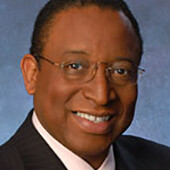TV Show
Highlights
From the Balkan Wars to both invasions of Iraq to the current refugee crisis, photojournalist Ron Haviv has been at the center of many of the world's most dangerous conflicts over the last three decades. In this fascinating talk, Haviv walks us through some of his most striking photographs and discusses the complicated ethics of being a journalist in a war zone.
Special thanks to Ron Haviv and VII Photo Agency for allowing the use of the photographs in this transcript. You can find more from Haviv and VII at www.ronhaviv.com; on Twitter, @ronhaviv; and on Instagram, @Ronhaviv_vii.
IntroductionRANDALL PINKSTON: Hello, everyone. We are going to begin our conversation with a legend in photojournalism, Mr. Ron Haviv: "Bearing Witness to War and Injustice: Ron Haviv, Photojournalist."
There is a very good possibility that most of you in this room have seen his work as cover pictures on magazines or images in stories about conflicts over the past three decades—Panama, the Balkans, Haiti, Darfur, Rwanda, Iraq, Afghanistan, Libya, the Arab Spring, Congo. Syria?
RON HAVIV: Not yet.
RANDALL PINKSTON: Not yet. That is on his to-do list.
And, of course, here at home: Katrina; Newtown, Connecticut; Ferguson, just to name some of the many troubled spots, at home and abroad, that Ron has documented with his excellent photojournalism.
He had been working as a professional photographer for only three years when he found himself in the midst of one of the most horrific conflicts of modern times, the wars in the Balkans following the breakup of Yugoslavia. As we observe the 20th anniversary of that conflict, Ron, of course, will share his up-close and personal perspective on that conflict and many others. He has brought some of the thousands of images he has recorded, but before we focus on those images, let's begin at the beginning.
DiscussionRANDALL PINKSTON: How did you become a photographer?
RON HAVIV: I actually just kind of fell into it. I was at NYU (New York University), studying to be a journalist. NYU is incredibly expensive, as many of you might know, and so I had multiple jobs to help pay for my tuition. I randomly got a job working for a fashion photographer and started to get exposed, on a very small end, working with his agent, to a little bit about the business of photography.
Around the same time, my uncle gave me a camera as a gift, and another friend of mine at NYU was a serious hobby photographer. I started getting hit by photography from all sorts of sides. At some point, which I still to this day cannot remember why or when, I decided that I would rather tell stories with photographs, rather than with words, and said, "Okay, I'm going to be a photojournalist."
RANDALL PINKSTON: But you did not set out to be a photographer. Did you have any interest in it as a hobby?
RON HAVIV: No interest. Many of my colleagues had dreamt about being photographers, had loved photography from a young age. I, for whatever reason, had no awareness, really, of photography.
Once I made that decision, I said, "Okay, I'm going to do this," and I started to teach myself photography. I took a basic intro to photography class and graduated and hit the streets.
RANDALL PINKSTON: Your first job:
RON HAVIV: My first job was not a job. It was an internship, working for free, mopping the floors, mixing chemicals, developing film—that's how long ago that was—working for a small newspaper that doesn't exist anymore. But the director of photography gave me a chance. Like everybody has that one break in their career, mine was—Mayor Ed Koch was the mayor of New York. He was holding some press conference. Nobody else was there to cover it. They said, "Here, kid. Here's your press credential. Go down to City Hall." An hour later, I'm crawling around the floor of the mayor's office. The next day I had my first picture published, with the credit font-sized [very small], of a circulation that nobody saw except me and my parents. But they were very excited. "Okay, you're going to do it. This is a good career choice."
I then started to enter the world of photojournalism. I started to meet photographers from AP (Associated Press), from AFP (Agence France-Presse), from New York Post, The New York Times, and entered this amazing world.
RANDALL PINKSTON: Were they generous with their advice?
RON HAVIV: Generous beyond belief. I think that is something that still exists today in journalism, but especially in photojournalism, with this real idea of trying to make sure that the next generation is there ready and able to take the reins. People would kind of put their arm around me and say, "Stand here," or "Let me introduce you to this editor or that editor." David Cantor, a freelance photographer in New York, brought me into AFP, Agence France-Presse. I got an internship with them and studied under Don Emmert, who is the bureau chief, and started to learn more about photography and started to be exposed to photography on an international level, watching the pictures come from other AFP photographers around the world.
RANDALL PINKSTON: Let's talk about your very first foreign assignment, Panama. How did that happen?
RON HAVIV: It's kind of a funny little story. I was covering the gay pride parade one day in New York and I saw this photographer walking around. He looked like he had walked off the set of a movie about photographers—good-looking guy, long blond hair, the requisite photojournalist scarf, press credentials. I went up and I started talking to him. I was just really enamored with this guy. I said, "So where are you going next?" He said, "Oh, I'm going to Panama." I said, "That's amazing. I'm also going to Panama." I didn't know where Panama was. I didn't know what happened in Panama. But I figured if this guy is going to Panama, that's the place to go.
This was so long ago I couldn't take out my iPhone and figure out what was happening in Panama, because there were no iPhones and there was no Internet. So I had to quickly do research. It was a very basic story: The dictator of a very important country, Panama Canal—Americans have a huge base there—was going to hold elections to prove to the world that he was loved by his people. That was the story.
RANDALL PINKSTON: But who sent you to Panama? Who was paying for that trip?
RON HAVIV: I got an assignment. I was freelancing for the New York Post. They gave me an assignment. They loved Noriega, the general. They called him "Pineapple Face," because he did all these crazy things and he had bad skin. They said, "Okay, you have your first foreign assignment."
The week before I am about to go, they changed managing editors. All travel was canceled, and I had nothing. I ran into Chris Morris, the photographer who I had met earlier, and told him the story. He said, "You know, I usually travel with my wife. She's not coming with me on this story. The airline has a buy-one-get-one-free special, like a free ticket, and you can have this ticket."
He said, "I'm on assignment for Time magazine. The room is paid for. The car is paid for. You're welcome to travel with me."
So it was like a workshop/job, and off I went.
RANDALL PINKSTON: You talk about a lucky break. Was that a lucky break or what?
RON HAVIV: Unbelievable. So generous. He is one of the most generous photographers around.
RANDALL PINKSTON: As a backstory—a front-story, really—when you went on this first foreign assignment, your pictures were noticed by the president of the United States.
RON HAVIV: They were.
RANDALL PINKSTON: Is this the image?
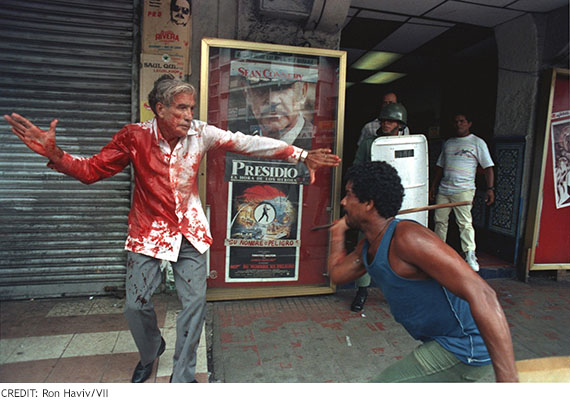
RON HAVIV: It's this one. This is the main image.
You saw the Newsweek cover and then Time did their own version.
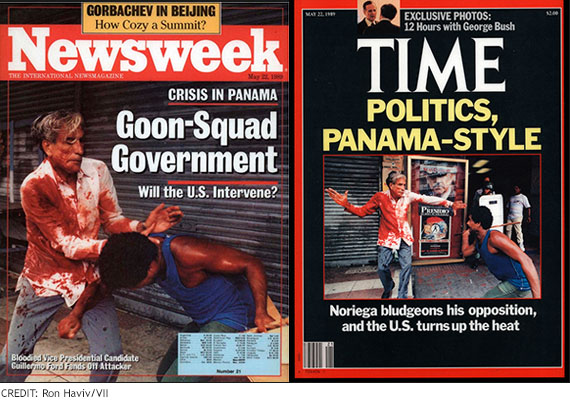
This is a photograph that took place—Noriega lost the election. He nullified the election. The would-be victors came out onto the streets to start an uprising. I wound up being the only photographer shooting color that day and was able to take this photograph of the vice president-elect. He is the one covered in blood. His bodyguard had been killed trying to protect him, lying on top of him. He was stabbed in the arm.
This was my first exposure to violence. What was kind of amusing, in a very odd way—in these very difficult situations there are always sort of odd things that happen—while the vice president was stumbling around and I was photographing him, I heard somebody say, "Con permiso," "Excuse me" in Spanish. It was this paramilitary guy who was asking to step around me so he could beat up the vice president.
RANDALL PINKSTON: While this is going on, you have no survival training, as we call it today, right?
RON HAVIV: None whatsoever.
RANDALL PINKSTON: No military training.
RON HAVIV: None.
RANDALL PINKSTON: People are being stabbed, being killed.
RON HAVIV: Yes.
RANDALL PINKSTON: Were you thinking that maybe your life was in danger?
RON HAVIV: At that particular moment I didn't really understand what incoming fire sounded like. I only realized later, when I heard it another time—I was like, "Oh, now I remember this sound."
No, this was complete baptism by fire, and very, very fortunate.
RANDALL PINKSTON: How did you know what to do in terms of composition, color, angles? How did you know where to stand, what to shoot? How did it come to you?
RON HAVIV: That is hopefully where my skills as a photographer come in. These are things that I think of very consciously, using these photographic aesthetics in order to capture a photograph, to have real meaning.
What is really amazing, I think, about this particular photograph is that you see there is a soldier standing in the back doing nothing and there are two movie posters, a James Bond poster and a Sean Connery movie. The titles in Spanish are His Name Is Danger and The Hour of the Hero. They are perfectly framed underneath the arm of the vice president.
Sometimes you get all those different elements coming together to really take the photograph to another level.
RANDALL PINKSTON: You knew that the poster said those things when you took that image?
RON HAVIV: I'll say I did.
RANDALL PINKSTON: Before we leave Panama, tell me about the president's comment about your image.
RON HAVIV: When this photograph came out, and it was on all the covers of the magazines, I was about 22 years old, and it really was—
RANDALL PINKSTON: This was your first cover on a magazine.
RON HAVIV: First cover, first real story. I was kind of like, "This photojournalism thing is really not that hard. You go somewhere, you take pictures, you get covers of magazines." Nobody had ever heard of me before. It was all really about me, about my career and what I can do and so on.
But six months later, when the United States invaded Panama and President Bush spoke to the nation as the troops were coming in—I was with the troops, so I didn't see the speech until later, but when I heard it, everything kind of switched. It wasn't about me. It wasn't about covers. It wasn't about awards. It was about the stories that we tell. It was about the people in the photographs. It was about playing this role in providing information and communication so you can make better decisions on who you vote for, what you think about the world. It was kind of understanding my role as a photographer in an entirely different way.
RANDALL PINKSTON: What did the president say about your picture?
RON HAVIV: He said, to paraphrase, "We all remember these horrible pictures of Vice President-Elect Guillermo Ford being beaten up by a so-called Dignity Battalion," which was the name of the paramilitary group. Then he went on to explain the reasons why the United States was invading.
RANDALL PINKSTON: Fantastic.
Now, to the Balkans. By now you have done that war in Panama.
RON HAVIV: I was in Kuwait when Kuwait was liberated. I had already been taken prisoner. I was in Iraq. I was a prisoner in Iraq for a while. I saw Nelson Mandela come out of prison. I photographed the Berlin Wall—
RANDALL PINKSTON: So by now you are an experienced war photographer.
RON HAVIV: Yes, I had done some stuff.
RANDALL PINKSTON: And you are dealing with some of the most infamous—who turned out to be later—war criminals of modern times.
RON HAVIV: Yes.
RANDALL PINKSTON: How did you befriend them and gain their trust to allow you to go with them as they were doing their business, their cleansing?
RON HAVIV: This is a photograph of a man named Arkan, who was the leader of a Serbian paramilitary group called the Tigers.
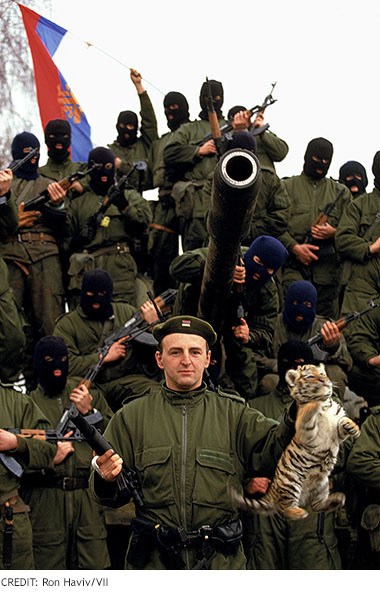
He fought, and his group fought, in all the different wars in the dissolution of Yugoslavia. This photograph was basically—I and a colleague, Alexandra Boulat—she and I later founded an agency together—we went up to him and we said, "Can we take a photograph?" He was very egotistical, very smart, a psychopath, responsible for killing thousands of people, but loved the camera and loved the press and thought that we loved him. He organized this whole photograph. He put his men up on tanks. As we were just about to take the photograph, somebody handed him a live tiger that they had liberated from the zoo in an earlier battle.
RANDALL PINKSTON: Next image, please. Where is this?

RON HAVIV: This is in Vukovar. Vukovar is a Croatian town that had been under siege for three months. It was the longest siege at that point since Stalingrad, Croatians surrounded by Serbs. I spent a lot of time on the Croatian side as they were defending themselves, until it was no longer possible to get back into the town. Then I went in with the Serbian troops as the town fell to Serbia.
This is a Serbian paramilitary couple celebrating their victory.
RANDALL PINKSTON: How long were you on the ground in the Balkans?
RON HAVIV: It was about 10 years for the whole thing to take place, so probably more than five years I was on the ground.
RANDALL PINKSTON: So you were there, throughout the conflict, throughout the fighting, for a year at a time?
RON HAVIV: No. It would depend on what was going on. Sometimes I would spend two weeks. Sometimes I would spend two months. The longest stretch was seven months at one time. It really kind of depended on what else was going on in the world and also what was happening there.
RANDALL PINKSTON: There were times—and the next image, I think, will demonstrate this—when you were told, "Don't take the picture," or you got a strong suggestion that they didn't want you to—tell us about this man.
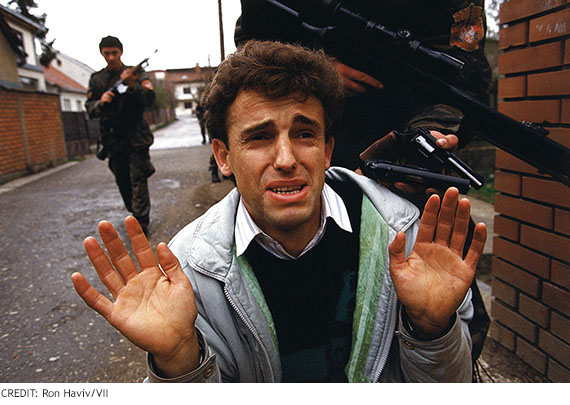
RON HAVIV: This man, whose name is Hajrush Ziberi, is an Albanian who happened to be in the wrong place at the wrong time. He was living in a town called Bijeljina, working there. Bijeljina was where the first civilians of the Bosnian War were killed. He is here being taken prisoner.
In this image here you see some of the first people to be killed. These are Arkan's troops, the Tigers.
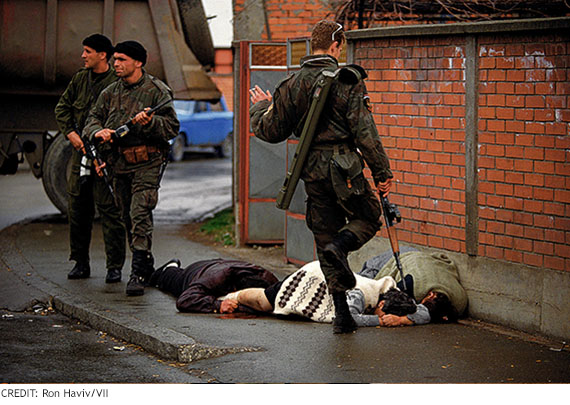
RANDALL PINKSTON: You were there before they were killed.
RON HAVIV: Yes.
RANDALL PINKSTON: You saw them being murdered.
RON HAVIV: I did.
The Bosnian War was the third war in this series of wars in Yugoslavia. By that point everybody knew, from step to step—from Slovenia, the first place, to Croatia, the second—that the third war was going to happen unless there was real intervention from the West. I went there as tensions were rising. While I was there, I got a call that this town, Bijeljina, had been split between Bosnian Serbs and Bosnian Muslims, and the civilians were fighting against each other.
By the third or fourth day, Arkan arrived with his troops and said he was there to liberate the town from Muslim fundamentalists. I asked him if I could go with his troops.
RANDALL PINKSTON: And he knew you from before.
RON HAVIV: He liked the photograph so much with the tiger that he let me go with his troops. I was able to go with them and witness them as they were committing these war crimes.
A photograph that is not here—it turns out that it is the butcher, his wife, and sister-in-law. At one point I was able to photograph the wife trying to save the husband. The whole time, they were telling me, "No photographs. No photographs."
RANDALL PINKSTON: The wife is in the white.
RON HAVIV: Yes.
RANDALL PINKSTON: And her husband is—
RON HAVIV: Is right behind her.
RANDALL PINKSTON: Right behind her. And who is the other person?
RON HAVIV: The sister-in-law.
RANDALL PINKSTON: So the husband was killed first, and while he is lying there bleeding, the wife comes out and pleads and tries to tend to him.
RON HAVIV: And then they shoot her.
RANDALL PINKSTON: And they shoot her. The sister-in-law?
RON HAVIV: Was brought out later, and then they shot her.
RANDALL PINKSTON: A couple of ethical questions here. Is there ever a time when you think that maybe it is too much to show the carnage?
RON HAVIV: I think it depends on how you show it. I think it's important that in situations where I am unable to stop something from happening—and unfortunately there have been many times like that—then it is the least that I can do to try to make sure that there is a document, that there is evidence of what occurred.
In the town of Vukovar—the picture you saw with the couple kissing—probably an hour before I took that photograph, I witnessed two other executions. It happened right in front of me. They didn't care that I was there. Then I tried to document it. I had a gun put to my head and told if I took a photograph, they would kill me. I made a promise to myself that if I was ever in this unfortunate situation again, if I couldn't stop it from happening, I would have to make sure that there was at least photographic evidence of what had occurred.
RANDALL PINKSTON: Didn't they tell you not to take these pictures?
RON HAVIV: They did. The whole time when they were shooting them and with what was happening, they were screaming at me, "No photographs! No photographs!"
RANDALL PINKSTON: But you are still taking photographs when they are telling you not to take photographs and they are killing these people.
RON HAVIV: I am, because there had to be something that came out of it.
RANDALL PINKSTON: But did it not occur to you that they could turn the weapon on you?
RON HAVIV: It did occur to me. I was very nervous. This particular picture, which is the only photograph that I have of them with their victims—I was literally shaking as I took that picture. But I needed to make sure that there would be irrefutable proof that they were responsible for this. So all I was trying to do was just frame them with the victims, when this young guy—he is a DJ. He lives in Belgrade. He is also a part-time drug dealer. He was very happy about this picture. He said it made him famous. He came from my left, and I was able to take that frame, and that was it.
RANDALL PINKSTON: What do you mean, he came from your left?
RON HAVIV: I was standing in the middle of the street. He didn't even see me. He just came past me and did that. I took one frame. I put the camera down. They turned and they looked at me, and I gave them a big smile and said, "Let's go." And off we went.
RANDALL PINKSTON: Oh, I see. So you had cover. You did this surreptitiously.
RON HAVIV: No. I was standing there in the middle of the street. They just didn't see me do it.
RANDALL PINKSTON: In your book you indicate that the soldier with the cigarette in his hand is actually kicking the couple after they are dead.
RON HAVIV: Yes, or they might even still be alive. I'm not sure.
RANDALL PINKSTON: This image was later used. Tell us about that.
RON HAVIV: This image, along with some other work of mine, was used in the International War Crimes Tribunal in The Hague to indict Arkan and also in the Miloŝević trial, as well as now we are waiting for a verdict against Radovan Karadžić, who is the political leader of the Bosnian Serbs. It was also used against him in his trial. Hopefully there will be an answer about his—
RANDALL PINKSTON: At the time you took this image, were you thinking that it might be useful at some point in a prosecution?
RON HAVIV: No. At this point there was no war crimes tribunal. The idea of journalists contributing to a war crimes tribunal was not even a conversation. It is a controversial conversation as it is. But this was just simply—for me, the war hadn't really started. I wanted these photographs to be published and I wanted there to be a reaction. The photographs were published in Time magazine and other magazines around the world. George Bush was still president. I thought to myself that he reacted three years earlier to my work in Panama; for sure, there will be some sort of reaction here. There were already troops on the ground, there to enforce the peace agreement for the other wars.
There was no reaction. A week later the war kicked off, and now here we are, celebrating this week the signing of the 20th anniversary of the Dayton peace accords.
RANDALL PINKSTON: It was Clinton who eventually launched the military action.
RON HAVIV: It was.
RANDALL PINKSTON: Talk to me about your impulse—I guess it was Anderson Cooper who said there is an impulse not to look, but a duty to take the picture and not to flinch. How do you balance that?
RON HAVIV: I really feel that I have a responsibility to be there for you, that I am your eyes in places where you are unable to go. So it is not up to me to say, "Oh, I don't want to see that," or "That's not proper." I want to do it in a way that is dignified and possible, but a way that you can relate to the photographs, but also for you to get the information, for you to understand what is going on. If I am not there to do that, there is no real reason for me to be there.
RANDALL PINKSTON: You have also talked about being the last person to see someone before they die, as was the case with this image, and people who are on the verge of death. This was a prisoner-of-war camp, I assume.

RON HAVIV: This was, yes. This was one of the camps that we found early on. Again, very little reaction from the world when these photographs came out.
RANDALL PINKSTON: Next image.
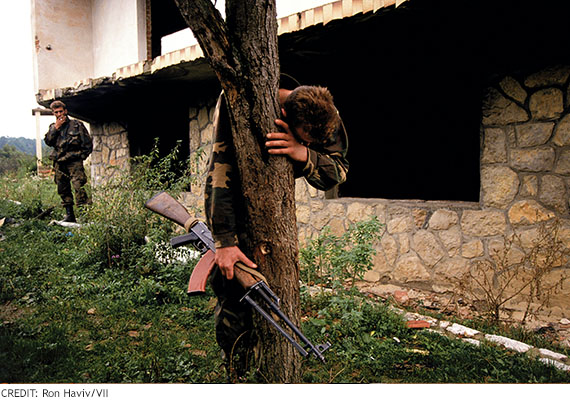
RON HAVIV: This is towards the end of the Bosnian War. This is Senad Medanovic. He was a soldier fighting to retake his village four years later. He brought me to his home. They had just taken the village. This is his house. In his front yard is a grave of 69 people, including his family. He is the only survivor. As we were leaving, he collapsed against the tree.
RANDALL PINKSTON: Next image.
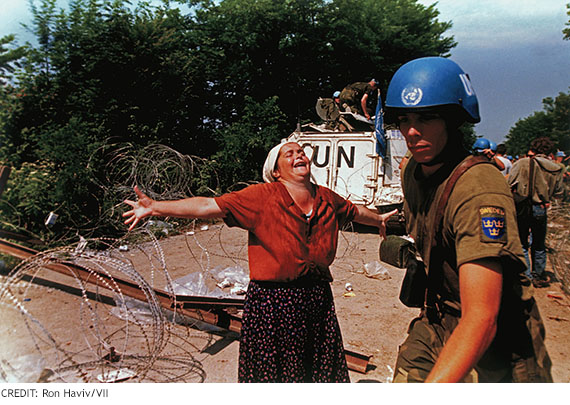
RON HAVIV: This is one of the survivors from Srebrenica, which is the act of genocide that was declared in Bosnia. It was also the impetus to launch the airstrikes. This woman has just come—her father, her brother, her son have all been killed. I was fortunate enough to meet her 20 years later, several months ago, in Sarajevo and to find out what has happened to her life. Basically, she spent the last 20 years still mourning and trying to find the remains of all her family.
These are also the widows of the victims of Srebrenica.
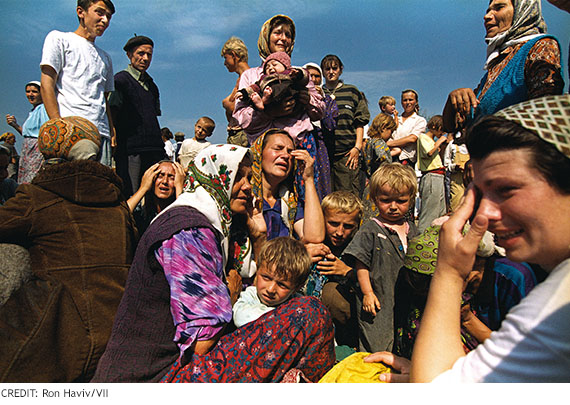
RANDALL PINKSTON: Tell me about the composition here, this framing.
RON HAVIV: I like this photograph because there are so many layers. You are seeing all of these different people. The only men are either very young or very old. There is obviously something missing. It's all the men that were killed. And the grief is just palpable. I walked up to them and I asked them what happened, and they all just started crying.
RANDALL PINKSTON: Where were they?
RON HAVIV: They had just arrived in Tuzla, at the UN base, which became their displacement camp.
RANDALL PINKSTON: When you are in a situation where people are on the verge of being shot or killed, do you see a duty to take the picture or to try to save their lives?
RON HAVIV: It is a case-by-case situation. In times when I have the ability to save someone, if I am the only person there, without question I am a human being first and a photographer second. If there are other people there to help, I am going to photograph the situation. If I feel like there is really nothing that I can do and I would lose my life, at this point I choose my life. There is very little that I can do.
RANDALL PINKSTON: And I have seen on one of your websites that you did save a man.
RON HAVIV: In Haiti?
RANDALL PINKSTON: In Haiti, yes.
RON HAVIV: There have been times when I have been able to intervene. I have bandaged people up. I have taken people to hospitals, taken people to feeding centers, and stopped people from being beaten or arrested, as many of my colleagues have as well. Even recently with Greece, taking refugees out of boats and helping them and not photographing.
RANDALL PINKSTON: Next image.
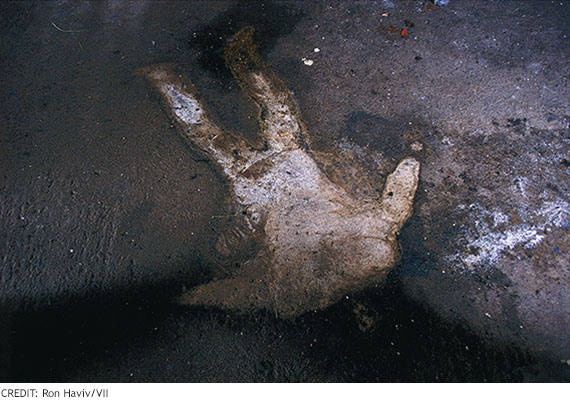
RON HAVIV: This is from Kosovo. This is the imprint of an Albanian man who was killed by Serbian forces.
This is from Afghanistan.
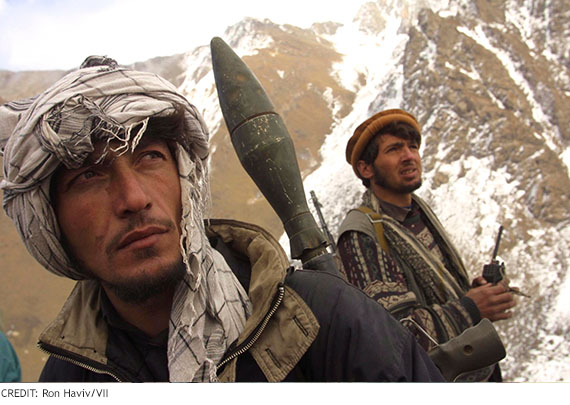
This is my project. I spent three months with the Northern Alliance in 2001. After 9/11 I went there and basically was there for the liberation of Kabul, living in Afghanistan, in the north.
RANDALL PINKSTON: Is that in Kabul or is that with the Northern Alliance?
RON HAVIV: This is with the Northern Alliance. This is on the front lines against the Taliban.
This is during the day that Kabul fell.

These are two young Taliban soldiers. These are Northern Alliance fighters. In one of these very odd situations, they came, they saw me on the road, the Northern Alliance fighters, they said, "Come. We want to show you something." They brought me into this vehicle, and they said, "We're going to kill these guys." I had a little dictionary. My Dari is not very good. I basically was able to convince them that I was a CIA (Central Intelligence Agency) officer and that they needed to not kill them and to bring them to their commander, which they did.
RANDALL PINKSTON: So you saved the lives of these two Taliban guys.
RON HAVIV: As far as I know.
RANDALL PINKSTON: At least at that point, yes.
RON HAVIV: This is a Northern Alliance commander.
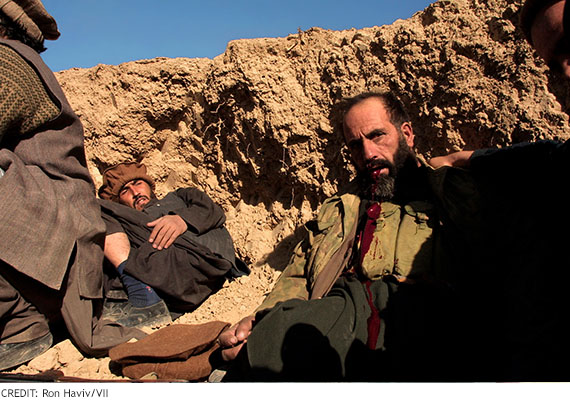
This is fighting outside of Kabul. This is going to your point about being with somebody at those last moments. This commander was very happy that I was there to document them as they were trying to liberate this area against the Taliban. We were in a very bad military position. We made a mistake and we wound up in open ground, with the Taliban on a mountain. I and Tyler Hicks from The New York Times and these Afghan soldiers were stuck in this crater that had been created by one of the B-52 bombs. We were just waiting for the Taliban to launch a shell into the hole. Then all of a sudden he was shot.
RANDALL PINKSTON: The one on the right or the one on the left?
RON HAVIV: The one with the blood coming down his—
RANDALL PINKSTON: Oh, goodness, I didn't realize that.
RON HAVIV: So he is actually dying there at that moment.
RANDALL PINKSTON: You think it was a sniper shot or what?
RON HAVIV: Yes, it was a—people were shooting down from—
RANDALL PINKSTON: Was anyone else killed in the hole?
RON HAVIV: No, just him. Then there were some very nerve-wracking moments. Two of his men eventually—they were very brave—picked him up and ran out of the hole. Gunfire followed them. They managed to survive. Then two more guys got up and left. Then it was left for me and the New York Times photographer to figure out what to do. Luckily we survived.
RANDALL PINKSTON: Did you just sit tight or did you try to make a run for it, too?
RON HAVIV: We sat tight for a while. Then we tried to run. Then we fell down and we went back. Then we tried to get up again. They shot at us some more. Then we waited. It was one of these completely random—you didn't know what was the right thing to do. The only thing that was the right thing to do was not to have been in that actual position.
RANDALL PINKSTON: So we have heard the myth about the cat with nine lives. How many lives would you say a photographer has?
RON HAVIV: Hopefully more.
RANDALL PINKSTON: You have talked about life expectancy. Well, you talked about the fact that most war photographers are in their 30s, or they don't go past their mid-30s. You are a few years beyond that now.
RON HAVIV: Just a touch.
RANDALL PINKSTON: Just a little bit, yes. What is it about 20s and 30s that lends itself to what you do, and what is it that keeps you going beyond the usual shelf life?
RON HAVIV: I think all of us—when you are young, you have this sense that you are not vulnerable and you are going to live forever. As time goes on and things happen, you start to see that changing. You have life responsibilities that come into play. You make debates about what is worth it and what is not, as do I. I am a little bit more selective in what I do, but there are certain events that I think are very important, and I still think that my view and my eye is worthwhile.
RANDALL PINKSTON: Let's go to another image. This is a beautiful image. Tell us what we are seeing.

RON HAVIV: This is just a very symbolic image. These are burqas that I photographed probably the day after the Taliban fled from Kabul. For me, it kind of looks like the end. They are sort of hanging there, beautiful colors. They are just very symbolic for that particular thing.
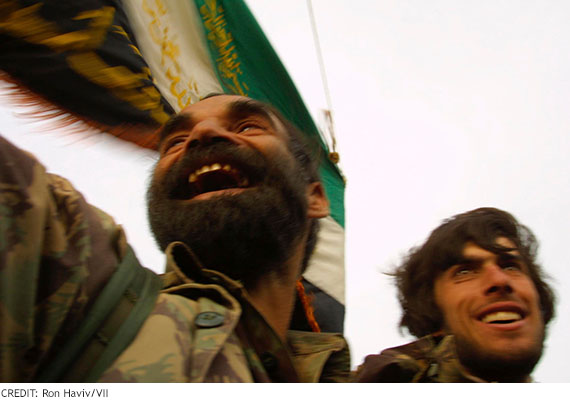
This is actually as we are entering the city. These were two Northern Alliance soldiers.
RANDALL PINKSTON: Next image, please.
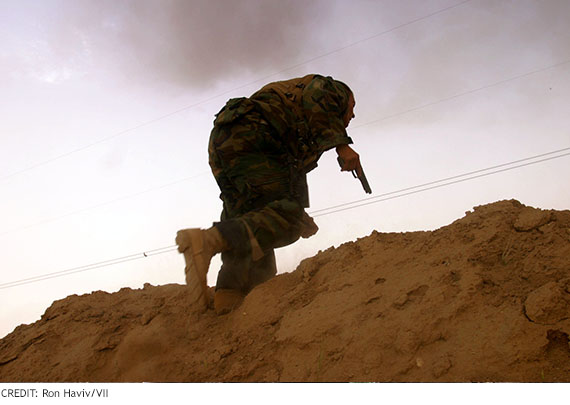
RON HAVIV: This is Iraq. I was embedded with the Marines, embedded with the Scouts, who were the unit that was supposed to draw contact to find out where the enemy was. So we were the first ones to cross into Iraq. Very brave, very young Marines. It was a very interesting experience to be embedded, fully part of their unit. I was with them for three months.
RANDALL PINKSTON: So this was before U.S. forces took the airport?
RON HAVIV: This is within the first couple of hours of crossing in.
RANDALL PINKSTON: Oh, my. At that point, Saddam's troops are still firing back, right?
RON HAVIV: Yes, we were still engaging, for sure.
RANDALL PINKSTON: Not long after that, they sort of disappeared and faded away.
RON HAVIV: Depending on where you were. There were different battles happening in different places.
RANDALL PINKSTON: Next image, please.

A famous image. Notice, if you will, the American flag on the top of Saddam's head. We have all seen the statue fall. How many of you have seen the statue with the flag on the head?
RON HAVIV: See, it did happen.
RANDALL PINKSTON: We knew it happened, but I just recall seeing the statue, but no flag. Tell me about the flag.
RON HAVIV: There are a lot of different stories about this. Peter Maas wrote a great piece, the huge backstory about why this happened and why it became so well known. Basically it was because this is where the hotels were that were housing all the journalists and we were going live.
RANDALL PINKSTON: The Palestine Hotel, the Baghdad Sheraton, yes.
RON HAVIV: So the Marines arrive there. I was actually standing next to the commander when one of the Iraqis who were trying to knock down the statue with small hammers walked over to him and said, "Could you please help us take down the statue?" The commander said, "Okay, fine. I'll help you." Then they set this up. Then one of the Marines went up and put that flag over. Within moments, the commander got a phone call, I assume from Washington, screaming, "Take that flag down!"
RANDALL PINKSTON: So there was a live image of that.
RON HAVIV: This was going live. You probably saw it on television. There were a number of journalists there because many of the journalists that had been embedded on the Iraqi side were all based right there.
RANDALL PINKSTON: So they were told to take the flag off because . . . ?
RON HAVIV: Because the Americans went from the idea of being liberators immediately to being occupiers.
RANDALL PINKSTON: And didn't want that flag to represent occupation.
Next image, please.
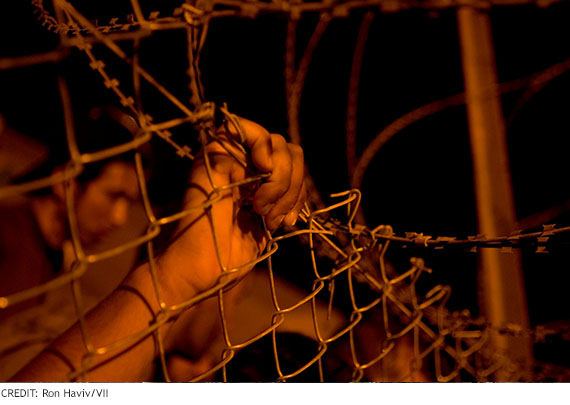
RON HAVIV: This is a story that I did for Vanity Fair about Abu Ghraib. We went and we investigated and found a lot of things about the secret rendition sites and what was actually happening. Afterwards, of course, after the photographs came out and it was more of an investigative piece, we found one of the Iraqis that claimed to be the man in the hood. It was a very interesting experience in investigative journalism.
RANDALL PINKSTON: Where are we here?
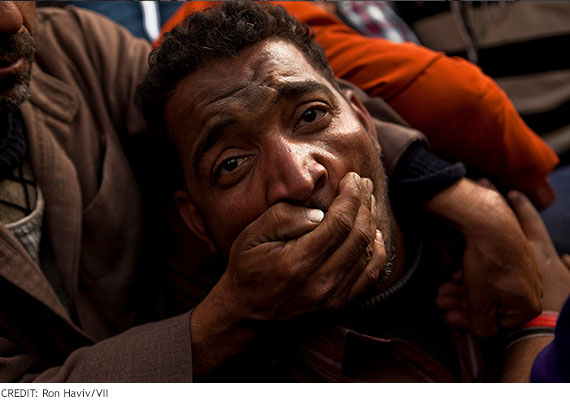
RON HAVIV: Now we are in Egypt. This is from 2011, from the Arab Spring. This was the fall of Mubarak. This is again one of these very odd situations. Tahrir Square filled with anti-Mubarak people in the center, pro-Mubarak people on the outskirts. This man kind of waded into the crowd and started screaming pro-Mubarak slogans. Within seconds, they just grabbed him and dragged him off. A mob just descended on him.
RANDALL PINKSTON: How did you get in the middle of that mob to take this image?
RON HAVIV: This is right before the mob—they were about to drag him away. I photographed him here as he realizes that he made a very stupid mistake. He was dragged off into the mob. I had befriended an Egyptian-American guy who was six foot seven and weighed 250 pounds. A very nice guy. I grabbed him and I said, "You have to go and get that guy and get him out of the crowd." So he waded in and literally picked the guy up by the scruff of the neck and dragged him off and handed him over to the army before he was beaten too badly.
RANDALL PINKSTON: Saved his life.
RON HAVIV: He did. He absolutely did.
RANDALL PINKSTON: Well, no, you saved his life because you sent the big Egyptian guy in there to get him.
We are going to open the floor for questions in just a few minutes, but just flip through some more.
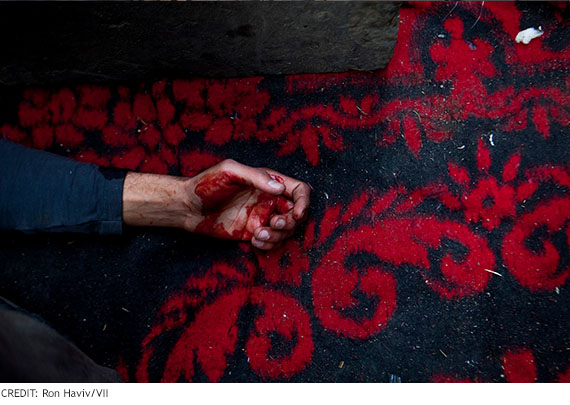
RON HAVIV: This is also from Egypt. There were obviously many people wounded. There were makeshift hospitals and so on around Tahrir Square.
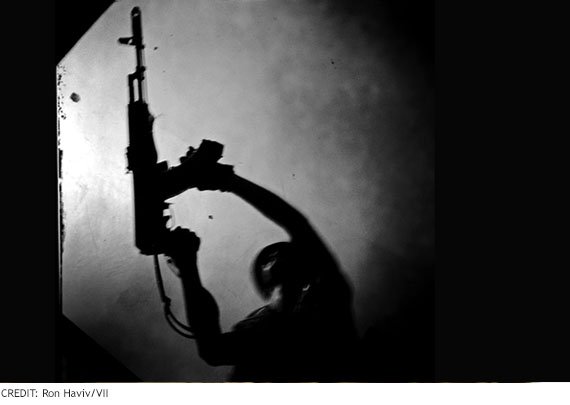
This is from the fall of Tripoli. I was with the Libyan rebel forces. They were fighting the last remnants of the Qaddafi forces.
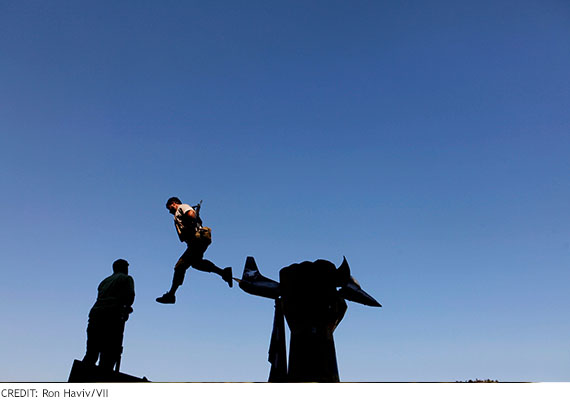
This is the famous statue in Qaddafi's compound, with Libyan rebel soldiers.
RANDALL PINKSTON: What is he doing? He is jumping—
RON HAVIV: He is jumping off the statue onto another platform.
RANDALL PINKSTON: Next image, please.

RON HAVIV: These are some victorious soldiers.
RANDALL PINKSTON: Another.
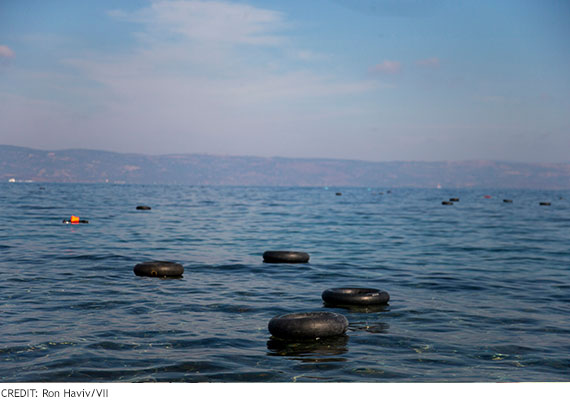
This is the refugee crisis, what I call "Exodus 2015." What body of water is this?
RON HAVIV: This is the Aegean. This is Lesbos. This is from about six weeks ago.
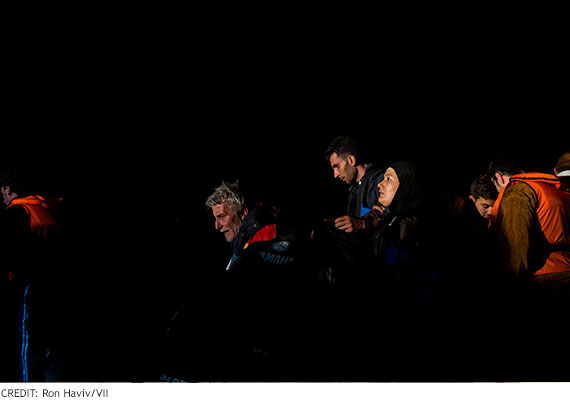
I was there documenting these guys coming across, mostly Syrian, but Iraqi as well and some Iranians and Afghans coming across.
RANDALL PINKSTON: Next image.
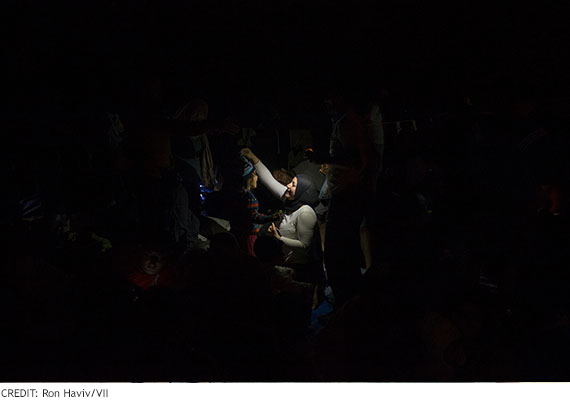
RON HAVIV: This is a mother and child. They were given donated clothes. They were trying them on.

Here they are sleeping in the streets before beginning the next part of their journey.
RANDALL PINKSTON: Hold that image, please. You have talked about why you shoot color, not black and white, and also how you try to compose your images to have artistry in them to draw people to look at the tragedy.
RON HAVIV: Yes. As I said earlier, I think the photographic aesthetics are incredibly important. I really want you, more than the content initially, to have a relationship with the photograph because of the visuals. If you are connected to the visual because of color, because of light, because of composition, when you actually understand the content, it is that much harder to look away. I want you to have that relationship. So I am very conscious.
I am also criticized for making horrible things too beautiful—war porn, things like that. But for me, I disagree. I think it is the only way to do it, especially today, when we are inundated with so many images. It is only going to be by the skill of the photographer that it is going to grab your attention.
QuestionsQUESTION: Susan Gitelson.
The photographs are obviously extraordinary and dramatic and memorable and have many other good qualities. But there is something missing, especially for Carnegie Council, and that is photographs of people who have survived the wars and have returned to their homes, and they are rebuilding and they are happy and they are joyous—the other side of things, people who are planting rather than destroying. Do you have photographs like that also?
RON HAVIV: I do. I do have work like that. But I have spent more of my time on the causes rather than the results.
QUESTIONER: It's not surprising. It probably sells better. But—
RON HAVIV: No, I wouldn't say that. But I think that it is important for people to understand, while things are happening, what they can do to intervene. I think that it is also important to understand what happens afterwards.
I think there is a lot to photograph in the world. I try to photograph what I can. It is certainly not motivated by money. I can guarantee you, this is not a job where funds are the incentive. It is the opposite of that.
QUESTIONER: But how about peace as an incentive?
RON HAVIV: I think peace is absolutely important. I and my colleagues are actually working on a project called Peace, where we are going back to places that we covered at times of war and going to see exactly what you are talking about.
RANDALL PINKSTON: As was the case with the woman in Sarajevo, with the outstretched arms. He put on an exhibit from 20 years earlier, and people who survived that horror came to your exhibit, including that lady.
RON HAVIV: They did.
QUESTION: My name is Olga Barkova, and I am from New York Medical Center IT department.
Thank you very much for a very wonderful discussion and interesting facts about your profession to be a photojournalist. My question is, almost half of your life you have spent in a war zone. But when you come back, how do you adjust to life?
The second question is, what are the advantages you have gained from all of your experience? What are the advantages of your profession?
RON HAVIV: Acclimation is very important. It is essential. It took me quite a long time to understand how to do that. For the first three or four years of my career, I didn't understand how to come back to New York. I came back always with a state of war in mind rather than my normal sense of being in New York. Once I realized that it was my responsibility to readjust—that this is my normal state, not war—it became a lot easier to do so. But it was difficult. I am sure a lot of ex-girlfriends can attest to that.
RANDALL PINKSTON: Did you ever get therapy or counseling?
RON HAVIV: I have spoken to people, certainly starting from the time in Bosnia. There is a Canadian doctor named Dr. Anthony Feinstein, who did a study about journalists and PTSD (posttraumatic stress disorder) and found that we who are documenting these types of conflicts suffer the same percentage as military and police. Since that study has come out, most news organizations now are taking the idea of making sure that their correspondents, when they come back, talk to somebody. They find out what is going on. They try to support them. It can be very difficult.
On the second part of your question, on the completely non-altruistic side, I saw the Berlin Wall come down. I watched Nelson Mandela walk out of prison. I saw the statue come down in Baghdad and was in other amazing places. It is such a privilege for me to be able to see that for myself and then even a greater one to be able to show my interpretation to you. I love history and I love to see things that are happening. This is a great advantage.
QUESTION: Don Simmons.
In this day and age, in any scene of violence or where news is breaking, a fair percentage of the people just walking around randomly have smartphones. The world is inundated now with pictures. Every now and then somebody must get a very good one. My question is, how does this affect your profession and your professional opportunities?
RON HAVIV: I think it's great that there are so many more photographers out there. I think a lot of these events were never seen before. They certainly wouldn't have been covered by me, because I wouldn't have been able to get to X, Y, and Z like somebody else who happened to walk by. I think more information we all have about what is going is always positive.
But there is a difference between the citizen-journalist or the citizen-photographer and me and my colleagues. We are approaching things as journalists, using journalistic rules and ethics. We are trying to tell stories. We are trying to do more than just one photograph.
I think there is room for both, without question.
QUESTION: I'm Krishen Mehta.
In the United States, as you know, there is a big issue of gun violence. Because of the pressure of the gun lobby, the federal government is not even allowed to keep records of victims of gun violence, homicides, and so forth—because of these pressures. So the public awareness is quite diffused as to what is really happening. Is there a role here for photojournalists to really address this issue hands-on so that the public can then bring more political pressure on the leadership of this country to bring about change and counter the tremendous pressure of the gun lobby to prevent this to be very well-known? The result is, we see mass shootings constantly. Is there a role here to have the public be better educated about this very important issue, to counter this pressure?
RON HAVIV: Absolutely, and there have been a number of very long-term projects. A photographer named Zed Nelson did a thing called Gun Nation. Jon Lowenstein has been working in Chicago, on the violence in that city, for a very long time.
I think one of the things is that we have to also understand as an audience that you can't be passive consumers. There is a lot of great work out there, but you have to be a little bit more active to try to find it. We will try to do our best to bring it to you, but given the way that media is fragmented today and the way that the web works and so on—there is stuff out there, but you have to try to find it and then take some responsibility for you to tell the next person and so on. There is always going to be room for more stories to talk about important issues like gun violence.
But the work has been done. I haven't done it personally, but there has been some very powerful work done.
QUESTION: Youssef Bahammi.
I have mostly a technical question regarding the job. Who takes care of the captions in a situation of emergency? Is also part of your job to comment on the pictures or write articles if needed, or it is purely photographic?
RON HAVIV: The captions are my responsibility. The text that accompanies the photographs is mine. It is incredibly important. It must be put into context and it must be very factual and deliberate. Sometimes I work with a journalist and, together, our work gets seen in one publication or another. Or sometimes my photographs are sold to a magazine who hires somebody else to marry it. Or sometimes it is just the photographs only. But I have the ability, not only with the photographs but with words, to really make sure that this is the viewpoint of what I am saying and these are the facts, in the hope that the work is not misused or misunderstood.
QUESTIONER: So you have to agree on what has to be said regarding the picture, like comments-wise?
RON HAVIV: Comments-wise, this is fact. This is a Syrian refugee who just arrived looking back at Turkey.
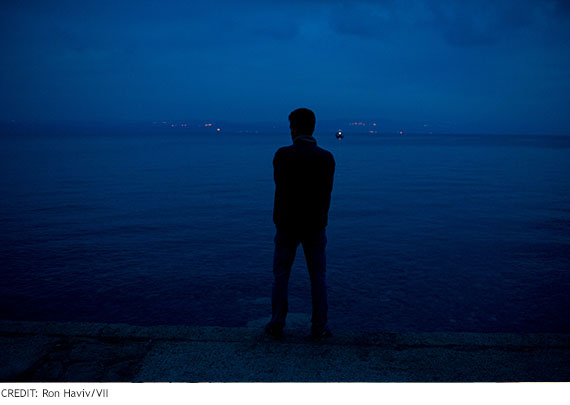
It is very simple. The place is Lesbos, Greece. He is leaving in 10 minutes to go off on his way to Macedonia.
QUESTION: Hi. My name is Scott Ulanoski.
Looking at your pictures of the tragedies and massacres that you took in Bosnia and I am assuming elsewhere, I was wondering if you could discuss the process or any kind of action that you may take if you see a massacre, what you do with those photos or how you go about reporting that to the right authorities.
RON HAVIV: Usually in situations like that, we try to find people from Human Rights Watch, often, or the UN, depending on who is where. Often we will share the work with them and then let the investigators take over. As a journalist, my story is there for the public, so they are welcome to use my experience or whatever that I saw.
RANDALL PINKSTON: You have talked about some situations where your film was taken away from you by soldiers in Bosnia, but yet you managed to also save some. Tell us about that. Where is a hiding place, if you can share that publicly? How many rolls do you imagine have images that have been lost because they were confiscated?
RON HAVIV: The best hiding place has been a bag of cookies. That was very successful. I said to them as I was being arrested, "Can I take my cookies?" And they said, "Sure, go ahead." Other times it is simply throwing them into a car.
In fact, with the scene of the man with his hands in the air, after I took that photograph, we were brought back to the headquarters. While I was standing, waiting for Arkan to come and give me permission to leave, he was thrown out of a window. He, amazingly, survived the fall. He was sort of beaten right in front of me, and I was photographing that as it was happening. Then they brought him back into the house. Moments later, Arkan arrived, and somebody ran up to him and said, "That guy just photographed this and that." So Arkan came over to me. He spoke perfect English. He said, "I need your film." I said, "Why?" He said, "I'll develop the film and I'll let you know what I like and what I don't like." Then I said to him, "Look, you don't know very good photo labs. I'll develop the film and bring it back to you." We had this argument about the quality —
RANDALL PINKSTON: Arkan let you argue with him.
RON HAVIV: We were arguing about it, until I realized, "Okay, enough is enough." At that point I had already hidden the film that you already saw. I knew I was going to lose it, but I wanted him to think I was fighting very hard for the film in the camera, which I did lose.
QUESTION: You are starting to allude to my question. I'm Carol Spomer.
How did you deal with the language issue?
RON HAVIV: It would depend. If it wasn't in a conflict area, I would work with a translator. But as soon as it would be too dangerous, I wouldn't want to be responsible for anybody else's life. But at that point, when the majority of what I am doing is photography, they know what I want, I know what I want, and it is sort of body language, hand signals, and broken German, English, Spanish, or whatever common language we could find in any particular place. But the camera is pretty universal, and people understand it.
QUESTIONER: I guess I am thinking—like the three people that you photographed that were killed and the one being kicked, how did you know they were husband and wife and sister, whatever?
RON HAVIV: This was a very famous situation that has been studied and researched. I found out all that information afterwards.
QUESTIONER: Oh, after the fact.
RON HAVIV: Yes. At the time, I had no idea. I just knew that they were middle-aged, unarmed civilians.
QUESTIONER: The other question I have on a personal level—here you have to have the objective eye and the steely reserve. To what extent did you have difficulty holding back acting or reacting emotionally to the horrors you were seeing?
RON HAVIV: I try to find a fine line. If I go through this completely robotically, I think my photographs will feel robotic. But at the same time, I can't be overwhelmed emotionally because then I am just going to be there crying. I am not going to even be able to take any photographs. So I have to find that middle ground. When I get home, there is plenty of time to really be upset.
QUESTION: It's Susan Ball.
I don't think we have talked anything about the equipment. You are doing digital now, right?
RON HAVIV: Now I am, yes.
QUESTIONER: Does that allow you to do things much better, easier, quicker? Do you just take one camera? I don't know how you get around carrying all this gear.
RON HAVIV: I still take a number of cameras, because cameras break. But it has made getting the work out much easier, which has been great. At the same time, because the work is available now everywhere, it is becoming much more difficult to work in the field. Colleagues of mine going to Syria have been Googled at the border. "Oh, what kind of work have you done? Oh, we don't like this. You're not coming in." Or on the way out, if they have been sending pictures while they were there and somebody sees the photograph and doesn't like the photograph, it is a real problem. So the digital age has had a benefit, but also made it very difficult.
A few years ago a writer working for The New York Times published a piece that was against the powers that be in Basra, Iraq. The piece came out while he was still there, and they killed him.
So it is no longer that my work is only just for you in New York or America. The work is now seen, no matter what publication you are working for, all over the world. And it is changing to some degree the way that we are able to work.
QUESTIONER: You are carrying all this equipment around while you are doing this, right?
RON HAVIV: So far, yes.
QUESTION: Have you ever taken a photograph that you thought was too awful to make public?
RON HAVIV: I have tried to be very judicious with taking gratuitous photographs and tried to find a way to do that using, obviously—probably the most obvious example being a body. There are ways to photograph it that it looks like an autopsy photograph that you are not even going to be able to look at or other ways to do it where you are going to find a way to at least understand what is going on.
QUESTIONER: I am thinking more that you have your camera pointed at something and all of a sudden something really horrible happens that you just are chancing to take.
RON HAVIV: No, I have not had that experience.
RANDALL PINKSTON: You were talking about the new technology. I am wondering, do you use the wireless capability that some cameras now have to send the picture right out of the camera without going through the computer or anything of that sort?
RON HAVIV: I haven't done that, but I have gone from the camera to a phone and then out like that.
RANDALL PINKSTON: You have written that—I think I am quoting you here—that imagery that was primarily once the domain of the visual journalist can now be witnessed, documented, and shared by us all because almost everyone has the right tool in their hands. The question is, does the volume of imagery take us to another level of numbness or fatigue, or will it increase the urgency to respond to what we see? What do you think?
RON HAVIV: Good question. I think it could go both ways. I think that there is this idea about war fatigue or famine—"Oh, we've seen these pictures. I don't want to see any more. Oh, another picture from Syria. Oh, another picture from the refugees." And people are just like, "I'm so tired of this. What else is new?"
For me, the question should be from the viewer not, "Why do I have to keep looking at this?" It is, "Why am I still looking at this?" Why is this still happening? Why are we still looking at photographs from the war in Syria? Why are we still looking—Darfur has now been going on for 12 years. Why are we still seeing photographs? Whenever they allow a photographer to work there, why are those photographs still coming out?
I think that is why it has to sort of be flipped. It is very easy to say, "I am overwhelmed and inundated with imagery." But when you start to take away the cat pictures and the lunch pictures and so on, and actually look at some of the work that is out there, there are images there that should be motivating you or educating you or having some sort of impact on you, and not just swiping to the next screen.
RANDALL PINKSTON: You have begun, with some of your colleagues, a photo organization called VII.
RON HAVIV: Correct.
RANDALL PINKSTON: Tell us about that.
RON HAVIV: VII is a collective owned by the photographers. It is very small. We are about 18 photographers now, all dedicated to covering the world around us. We started in 2001. We actually started on September 9, and two days later, obviously, the world changed. We were there and have been there at the forefront documenting the world.
RANDALL PINKSTON: How does your agency differ from other photography agencies, Magnum, etc.?
RON HAVIV: We are very similar to Magnum. We are just a smaller and younger version of that. But we differ from wire services and so on. We are individual freelance photographers. We make our own choices on where we go. We collaborate on group projects, such as the Peace project that we are working on now and other things like that.
QUESTION: Amtissal Aboulissan.
You mentioned earlier that you have yet to cover the Syrian War. I am wondering if that is a personal decision based on situations like other journalists being Googled at the border.
Also, have you covered ever the Israeli-Palestinian conflict? If you have, I'm wondering about your experience or experiences there.
RON HAVIV: I have not yet found a way that I feel that I can cover the Syrian conflict safely. Once I figure that out, I will be sure to do so.
I have covered the Israeli-Palestinian conflict. I was there for the Second Intifada and numerous times afterwards. That is obviously an intractable issue at this point, but a place where I think journalism plays a very important role. I think it is important for everyone to see both sides of the story. I think that it is becoming more and more difficult as both Hamas and the Israeli side attempt to control access unless it benefits them directly. It is just another thing that we continue—many colleagues are spending a lot of time there, certainly recently, in the last few years, documenting what is going on with that.
RANDALL PINKSTON: We didn't talk at all about your domestic assignments. Most recently you have been in Ferguson, Missouri.
RON HAVIV: Yes.
RANDALL PINKSTON: Newtown, Connecticut.
RON HAVIV: It is the anniversary, actually, of Newtown.
RANDALL PINKSTON: Today is, yes. Are there any parallels between those kinds of assignments and what you usually do abroad?
RON HAVIV: Absolutely. I have a piece that I did where I took quotes from different people that I met and listened to—politicians, refugees, soldiers, as well as L.A. gang members and people in Ferguson and so on. When I took away the attribution of who said it, it was all interchangeable. Everybody was saying the same thing. They weren't saying good things, unfortunately, but they were all saying the same thing.
The silver lining for me in that is that it is a bit of an understanding that all of us, no matter where we are from, are a lot closer to each other than we think. I spent a lot of time in L.A. working on a gang story. The gang members were saying exactly the same thing that Arkan was saying or that a Rwandan rebel was saying or so on.
RANDALL PINKSTON: Give me an example of commonality of perspective.
RON HAVIV: "This is our home. We will defend it against everybody. It's our family against that family."
It is always about the other: "They are different because of X, and therefore we will do X justification from here to there." It is such a common thing. The most common thing going across all of it is fear, fear of the other. We are seeing that, of course, today with the current conversation here in this country about the refugees, about fear of the other, not understanding what the other person wants. It is quite amazing.
I speak a lot, and the audiences that understand this the most are high school students. In the high school there are cliques and divisions, and if it is an inner-city school, you have multiple racial differences. They totally see that, "Oh, Darfur is just like blank"—on, obviously, a much smaller level. But it totally relates.
It is the hope that this work will get people thinking in order to surpass that, to change that thinking, which is obviously totally changeable if the right effort is made.
RANDALL PINKSTON: Thanks to you, Ron Haviv, progress can be made. I think that is a very good end point. But before we end, let me share with you that he has brought with him some of his works in print, including this book, Blood and Honey, along with Afghanistan: The Road to Kabul—
RON HAVIV: Testimony.
RANDALL PINKSTON: And The Lost Rolls. Very interesting. The Lost Rolls is about all of that film that you shot that you never got processed. Where can you get it done now? Are there any places to mail off film, like we used to do back in the day? I used to send mine to Mystic in Connecticut.
RON HAVIV: You can still take your film to Walmart and Costco and get your film processed.
RANDALL PINKSTON: That's good to know. Pull out those old rolls.
Thank you all so much. It has been an honor and a pleasure, sir, to meet you and to listen to your wisdom and your experiences. Thank you.
RON HAVIV: Thank you.


